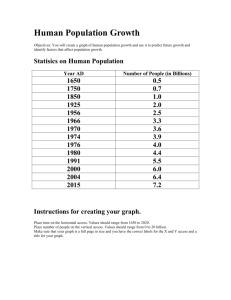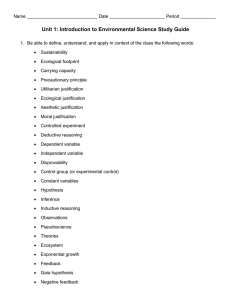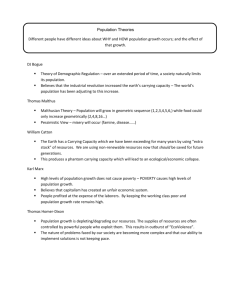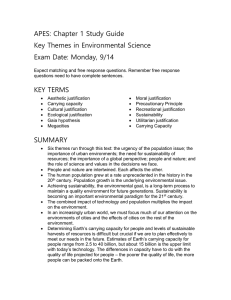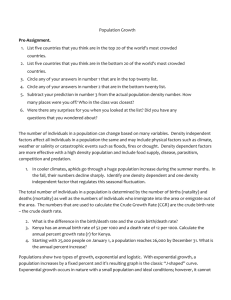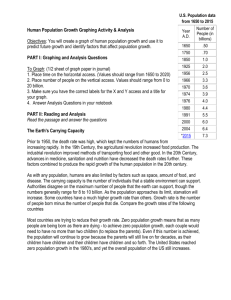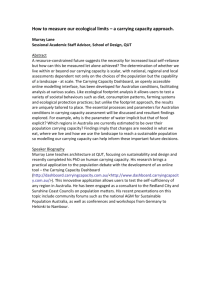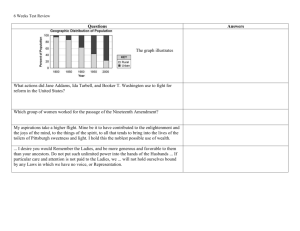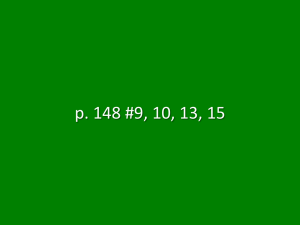Interpreting Graphs
advertisement
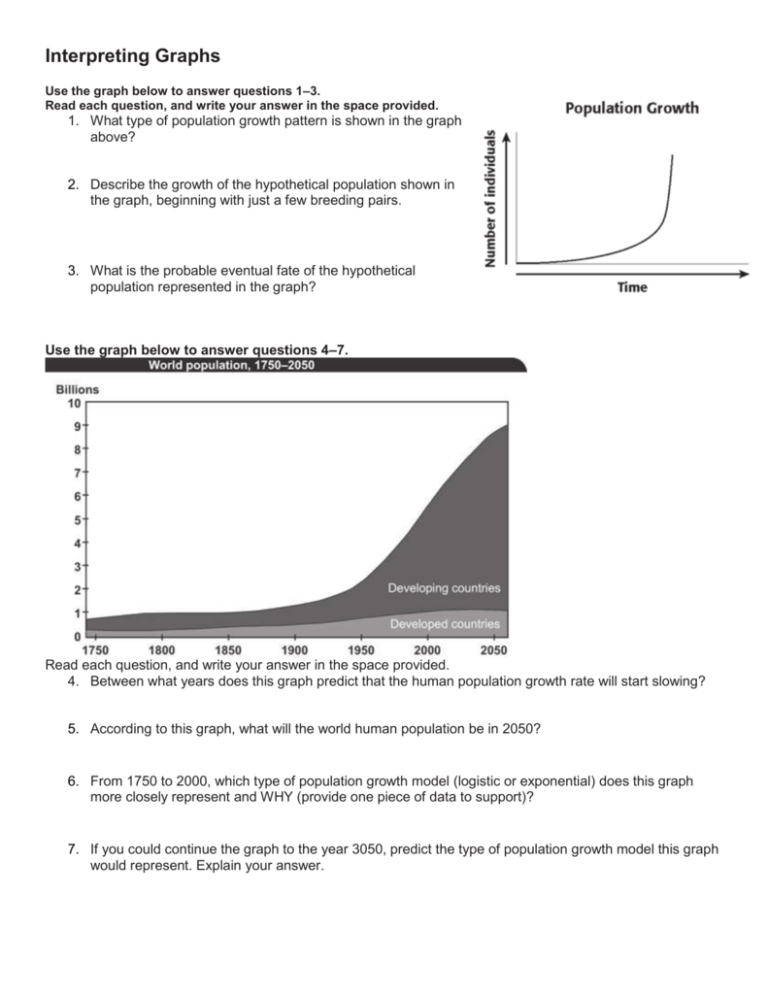
Interpreting Graphs Use the graph below to answer questions 1–3. Read each question, and write your answer in the space provided. 1. What type of population growth pattern is shown in the graph above? 2. Describe the growth of the hypothetical population shown in the graph, beginning with just a few breeding pairs. 3. What is the probable eventual fate of the hypothetical population represented in the graph? Use the graph below to answer questions 4–7. Read each question, and write your answer in the space provided. 4. Between what years does this graph predict that the human population growth rate will start slowing? 5. According to this graph, what will the world human population be in 2050? 6. From 1750 to 2000, which type of population growth model (logistic or exponential) does this graph more closely represent and WHY (provide one piece of data to support)? 7. If you could continue the graph to the year 3050, predict the type of population growth model this graph would represent. Explain your answer. Human Population Growth Name: /50pt Lab Objectives: You will create a graph of human population growth, analyze factors and conditions that affect it, and use it to predict future growth. Pre-Investigation Questions: Refer to the graph below: Use letters to answer the questions. 1. Refer to the illustration above. Which time period shows exponential growth of the population? 2. Refer to the illustration above. During which time period are the birth rate and death rate equal? 3. Which time period refers to when a population is in decline? Statisics on Human Population Year A.D. Number of People (in billions) 0 .25 1650 .50 1750 .70 1850 1.0 1925 2.0 1956 2.5 1966 3.3 1970 3.6 1974 3.9 1976 4.0 1980 4.4 1991 5.5 2000 6.0 2004 6.4 2010 6.9 2015 7.2 Instructions for creating your graph. Place time on the long horizontal (X) axis. Values should range from 0 A.D. to 2010. Place number of people on the vertical (Y) axis. Values should range from 0 to 8 billion. Make sure that your graph is a full page in size, you have the correct unit labels for the X and Y axes, and a title for your graph. Analysis 4. It took 1649 years for the world population to double, going from .25 billion people to .50 billion people. a. How long did it take for the population to double once again? b. How long did it take for the population to double a second time? c. A third time? 5. What growth model is human population growth for the 1st 1950 years? 6. What growth model is human population growth for the last 75 (or so) years? 7. Based on your graph, in what year will the population reach 8 billion? The Earth's Carrying Capacity: Human factors. Prior to 1950, the death rate was high, which kept the numbers of humans from increasing rapidly. In the 19th Century, the agricultural revolution increased food production. The industrial revolution improved methods of transporting food and other good. In the 20th Century, advances in medicine, sanitation and nutrition have decreased the death rates further. These factors combined to produce the rapid growth of the human population in the 20th century. As with any population, humans are also limited by factors such as space, amount of food and disease. The carrying capacity is the number of individuals that a stable environment can support. Authorities disagree on the maximum number of people that the earth can support, though the numbers generally range for 8 to 10 billion. As the population approaches its limit, starvation will increase. Some countries have a much higher growth rate than others. Growth rate is the number of people born minus the number of people that die. Compare the growth rates of the following countries Most countries are trying to reduce their growth rate. Zero population growth means that as many people are being born as there are dying - to achieve zero population growth, each couple would need to have no more than two children (to replace the parents). Even if this number is achieved, the population will continue to grow because the parents will still live on for decades, as their children have children and their children have children…and so forth. The United States reached zero population growth in the 1980's, and yet the overall population of the US still increases. Analysis: Use the graph you created and the information above to answer the following questions. 8. What factors contributed to the world's overall population growth in the last 150 years. List at least 4. 9. Why does a population not level off during the same year it reaches zero population growth? 10. What do you think the Earth’s carrying capacity for humans is? 11. If the carrying capacity of the earth was 9 billion people, when would this number be reached (according to your graph)? 12. What will happen when the human population exceeds the earth's carrying capacity? Explain in a few sentences. Population Growth Pyramids. LABELS: Analysis: Comprehensive population growth models. Answer the questions completely. 13. What is it called when a population increases at a steady, rapid rate? 14. Refer to the graph containing Germany. Which age group had the least amount of males? 15. Refer to the graph containing Guatemala. Which age group has the most individuals? 16. Which country has a nearly equivalent distribution for each age group? 17. Label the graph that illustrates a population “DECLINING”. 18. What is your justification? 19. Label the graph that illustrates a population “EXPANDING SLOWLY”. 20. What is your justification? 21. Label the graph that illustrates a population “EXPANDING RAPIDLY”. 22. What is your justification? 23. Label the graph that illustrates a population “STABLE”. 24. What is your justification? 25. Based upon what you know about these countries, what do you find interesting about the rate of growth of a country and its economy, standard of living, health factors, and other social influences?
